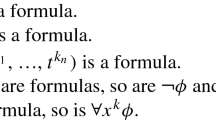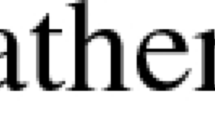Abstract
The view that plural reference is reference to a set is examined in light of George Boolos's treatment of second-order quantification as plural quantification in English. I argue that monadic second-order logic does not, in Boolos's treatment, reflect the behavior of plural quantifiers under negation and claim that any sentence that properly translates a second-order formula, in accordance with his treatment, has a first-order formulation. Support for this turns on the use of certain partitive constructions to assign values to variables in a way that makes Boolos's reading of second-order variables available for a first-order language and, with it, the possibility of interpreting quantification in an unrestricted domain.
A first-order theory, T(D), is developed on the basis of Boolos's treatment of simple plural definite descriptions extended to Richard Sharvy's general theory of definite plural and mass descriptions. I introduce a primitive predicate, o, for the relation of the referent of a singular description to that of its plural. If o is simply added to T(D), ε is definable in T(D), and the result is inconsistent. If o is added to a theory with axioms for the fragment of T(D) I call D-mereology, the result is a natural basis for the development of a ‘pluralized’ Zermelo set theory. This theory, however, is inconsistent in an unrestricted domain, unless it is recast as a second-order theory of sets interpreted in Boolos's way.
Similar content being viewed by others
References
Aczel, Peter: 1988,Non-Well-Founded Sets, CSLI Lecture Notes, Number 14, CLSI, Stanford.
Boolos, George: 1971, ‘The Iterative Conception of Set’,Journal of Philosophy 68, 215–31.
Boolos, George: 1975, ‘On Second Order Logic’,Journal of Philosophy 72, 509–27.
Boolos, George: 1984a, ‘To Be Is to Be the Value of a Variable (or Some Values of Some Variables)’,Journal of Philosophy 81, 430–49.
Boolos, George: 1984b, ‘Nonfirstorderizability Again’,Linguistic Inquiry 15, 343.
Boolos, George: 1985a, ‘Nominalistic Platonism’,Philosophical Review 94, 327–44.
Boolos, George: 1985b, ‘Reading theBegriffsschrift’,Mind 94, 331–44.
Bunt, H. C.: 1979, ‘Ensembles and the Formal Semantic Properties of Mass Nouns’, in Pelletier (1979), pp. 249–77.
Cartwright, Helen Morris: 1963,Classes, Quantities, and Non-Singular Reference, Ph.D. dissertation, University of Michigan, Ann Arbor.
Cartwright, Helen Morris: 1965, ‘Heraclitus and the Bathwater’,Philosophical Review 74, 466–85.
Cartwright, Helen Morris: 1970, ‘Quantities’,Philosophical Review 79, 25–42.
Cartwright, Helen Morris: 1975a, ‘Some Remarks about Mass Nouns and Plurality’,Synthese 31, 395–410 (repr. in Pelletier (1979), pp. 31–46).
Cartwright, Helen Morris: 1975b, ‘Amounts and Measures of Amount’,Noûs 9, 143–64 (repr. in Pelletier (1979), pp. 179–98).
Cartwright, Helen Morris: 1977, ‘Intuitive Set Theory’, unpublished.
Cartwright, Helen Morris: 1984, ‘Parts and Partitives: Notes on What Things Are Made of’,Synthese 58, 251–77.
Cartwright, Helen Morris: 1987, ‘Parts and Places’, in Judith Jarvis Thomson (ed.),Being and Saying, MIT Press, Cambridge, MA, pp. 175–214.
Cartwright, Helen Morris: 1988, ‘OnEk Relations and Sharvy's Theory of Descriptions’, unpublished.
Cartwright, Richard L.: 1989, ‘Speaking of Everything’, paper presented to the Association for Symbolic Logic, Los Angeles.
Chomsky, Noam: 1970, ‘Remarks on Nominalization’, in R. Jacobs and P. Rosenbaum (eds.),Readings in English Transformational Grammar, Xerox College Publishing, Waltham, MA, pp. 184–221.
Gillon, Brendan S.: 1987, ‘The Readings of Plural Noun Phrases in English’,Linguistics and Philosophy 10, 199–219.
Goodman, Nelson: 1951,The Structure of Appearance, Harvard University Press, Cambridge, MA.
Hallett, Michael: 1984,Cantorian Set Theory and Limitation of Size, Clarendon Press, Oxford.
Hendry, H.: 1982, ‘Complete Extensions of the Calculus of Individuals’,Noûs 16, 453–60.
Kripke, Saul A.: 1972,Naming and Necessity, Harvard University Press, Cambridge, MA.
Landman, Fred: 1989, ‘Groups I’, ‘Groups II’,Linguistics and Philosophy 12, 559–605, 723-44.
Lewis, David K.: 1991,Parts of Classes, Blackwell, Oxford.
Link, Godehard: 1983, ‘The Logical Analysis of Plurals and Mass Terms: A Lattice-Theoretical Approach’, in R. Bauerie and C. Schwartze (eds.),Meaning, Use and Interpretation of Language, de Gruyter, Berlin, pp. 302–23.
Parsons, Charles: 1974, ‘Sets and Classes’,Noûs 8, 1–12 (repr. in Charles Parsons: 1983,Mathematics in Philosophy: Selected Essays, Cornell University Press, Ithaca, pp. 209–20).
Pelletier, F. J. (ed.): 1979,Mass Terms: Some Philosophical Problems, D. Reidel, Dordrecht.
Pelletier, F. J., and L. K. Shubert: 1989, ‘Mass Expressions’, in D. Gabbay and F. Guenthner (eds.),Topics in the Philosophy of Language, Handbook of Philosophical Logic, Vol. 4, D. Reidel, Boston, pp. 327–407.
Quine, W. V.: 1960,Word and Object, MIT Press, Cambridge, MA.,
Quine, W. V.: 1969,Set Theory and Its Logic, rev. ed., Harvard University Press, Cambridge, MA.
Quine, W. V.: 1982,Methods of Logic, 4th ed., Harvard University Press, Cambridge, MA.
Quine, W. V.: 1983,The Roots of Reference, Open Court, La Salle.
Quine, W. V.: 1986,Philosophy of Logic, 2nd ed., Harvard University Press, Cambridge, MA.
Resnik, Michael D.: 1988, ‘Second Order Logic Still Wild’,Journal of Philosophy 85, 75–87.
Russell, Bertrand: 1919,Introduction to Mathematical Philosophy, 2nd ed., Allen and Unwin, London.
Russell, Bertrand: 1979,The Principles of Mathematics, 2nd ed., Allen and Unwin, London.
Sharvy, Richard: 1980, ‘A More General Theory of Definite Descriptions’,Philosophical Review 89, 607–24.
Sharvy, Richard: 1983, ‘Aristotle on Mixtures’,Journal of Philosophy 80, 439–57.
Simons, Peter: 1987,Parts, a Study in Ontology, Clarendon Press, Oxford.
Tarski, Alfred: 1983,Logic, Semantics, Metamathematics, ed. John Corcoran, 2nd ed., Hackett, Indianapolis.
Author information
Authors and Affiliations
Rights and permissions
About this article
Cite this article
Cartwright, H.M. On plural reference and elementary set theory. Synthese 96, 201–254 (1993). https://doi.org/10.1007/BF01306897
Issue Date:
DOI: https://doi.org/10.1007/BF01306897




